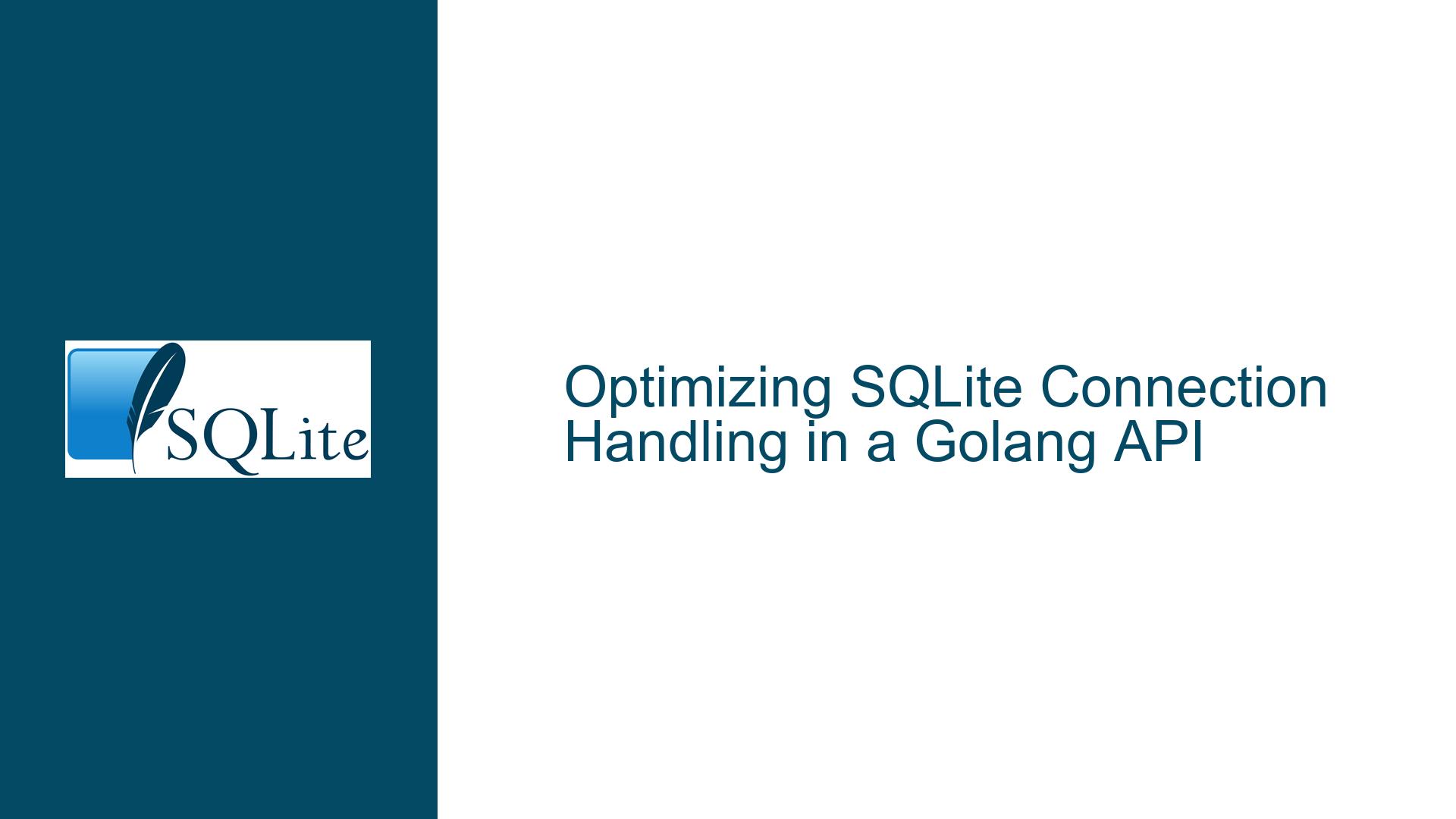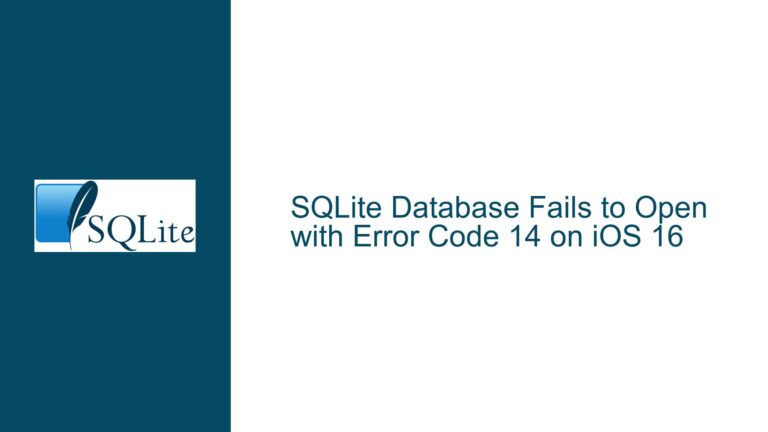Optimizing SQLite Connection Handling in a Golang API
Single Connection vs. Multiple Connections: Performance and Safety Considerations
When building a Golang API with SQLite as the backend database, one of the critical design decisions revolves around how database connections are managed. The choice between using a single shared connection or multiple connections (one per function) has significant implications for performance, safety, and transactional integrity. This guide delves into the nuances of this decision, exploring the trade-offs, potential pitfalls, and best practices for ensuring optimal database interaction in a RESTful API context.
Issue Overview: Connection Management in a Concurrent RESTful API
In a typical RESTful API built with Golang and SQLite, database connections are the lifeline of data interaction. The API handles various HTTP methods (GET, POST, PUT, DELETE) that translate into SQL operations (SELECT, INSERT, UPDATE, DELETE). The choice of connection management strategy—whether to use a single shared connection or multiple connections—depends on several factors, including concurrency, transactional requirements, and performance considerations.
Concurrency and Thread Safety
Golang’s concurrency model, based on goroutines, allows multiple functions to execute concurrently. When these functions interact with the database, thread safety becomes a concern. SQLite, while lightweight and efficient, has limitations in handling concurrent writes. Even in WAL (Write-Ahead Logging) mode, which improves concurrency, SQLite serializes write operations. This means that while multiple readers can operate simultaneously, only one writer can access the database at a time.
Transactional Integrity
Transactions are essential for ensuring data consistency, especially in scenarios where multiple operations must be executed atomically. For example, an API client might retrieve data using a GET request, modify it, and then update the database using a PUT request. If these operations are not wrapped in a transaction, there is a risk of data inconsistency due to concurrent modifications by other clients.
Connection Overhead
Opening and closing database connections incur overhead. Establishing a new connection involves resource allocation, authentication, and initialization, which can be time-consuming. Reusing a single connection eliminates this overhead but introduces challenges related to connection state and transactional boundaries.
Connection Lifespan and Cleanup
Properly managing the lifespan of database connections is crucial to avoid resource leaks. In Golang, deferring the conn.Close() method ensures that the connection is closed when the function exits. However, in scenarios where the application terminates abruptly (e.g., due to a signal interrupt), ensuring that the connection is properly closed requires additional handling.
Possible Causes: Why Connection Management Matters
The decision to use a single connection or multiple connections is influenced by several underlying factors, each of which can impact the performance and reliability of the API.
1. Transactional Boundaries
When using a single connection, all SQL operations share the same transactional context. This means that if one function starts a transaction using BEGIN, all subsequent operations on that connection will be part of the same transaction until a COMMIT or ROLLBACK is issued. This can lead to unintended side effects, especially in a concurrent environment where multiple goroutines might be executing database operations simultaneously.
2. Connection Pooling
Golang’s database/sql package provides built-in connection pooling, which can mitigate the overhead of opening and closing connections. However, SQLite’s lightweight nature and single-file storage model mean that connection pooling behaves differently compared to client-server databases like PostgreSQL or MySQL. Understanding how connection pooling interacts with SQLite is essential for optimizing performance.
3. Error Handling and Recovery
In a single-connection setup, errors such as connection timeouts or database locks can affect all subsequent operations. With multiple connections, an error in one connection does not necessarily impact others, providing a degree of fault isolation. However, managing multiple connections increases the complexity of error handling and recovery.
4. Resource Contention
SQLite’s locking mechanism ensures data integrity but can lead to resource contention in high-concurrency scenarios. WAL mode alleviates some of these issues by allowing concurrent reads and writes, but it does not eliminate contention entirely. The choice of connection management strategy can influence the degree of contention and the overall responsiveness of the API.
5. Application Architecture
The architecture of the API itself plays a role in determining the optimal connection management strategy. For example, if the API is designed to handle a large number of short-lived requests, the overhead of establishing new connections for each request might be prohibitive. Conversely, if the API handles long-running transactions or complex workflows, reusing a single connection might simplify transactional management.
Troubleshooting Steps, Solutions & Fixes: Best Practices for Connection Management
To address the challenges associated with connection management in a Golang API using SQLite, the following steps and solutions can be implemented.
1. Evaluate Transactional Requirements
Before deciding on a connection management strategy, assess the transactional requirements of the API. If the API primarily handles simple, independent operations (e.g., single SELECT, INSERT, or UPDATE statements), using a single connection with implicit transactions might suffice. However, if the API needs to support complex workflows involving multiple operations that must be executed atomically, explicit transactions are necessary.
In scenarios where explicit transactions are required, consider using a single connection per transaction rather than per function. This approach ensures that each transaction has its own connection, preventing interference between concurrent transactions. Golang’s database/sql package supports this pattern through the BeginTx method, which starts a new transaction with a dedicated connection.
2. Implement Connection Pooling
Leverage Golang’s built-in connection pooling to balance the trade-offs between connection reuse and resource contention. Configure the connection pool settings (e.g., SetMaxOpenConns, SetMaxIdleConns) based on the expected workload and concurrency level. For SQLite, setting a low maximum number of open connections (e.g., 1-5) can help mitigate contention while still benefiting from connection reuse.
3. Handle Connection Errors Gracefully
Implement robust error handling to manage connection-related errors, such as timeouts or database locks. In a single-connection setup, ensure that errors are logged and the connection is reset or reestablished as needed. With multiple connections, use retry logic to handle transient errors and prevent cascading failures.
4. Monitor and Optimize Performance
Use monitoring tools to track database performance metrics, such as query execution time, connection wait time, and lock contention. Analyze these metrics to identify bottlenecks and optimize the connection management strategy accordingly. For example, if connection wait time is high, consider increasing the maximum number of open connections in the pool.
5. Ensure Proper Connection Cleanup
Implement signal handling to ensure that database connections are properly closed when the application terminates. In Golang, this can be achieved using the os/signal package to capture interrupt signals (e.g., SIGINT) and execute cleanup logic before exiting. Additionally, use defer statements to close connections within functions, ensuring that resources are released even in the event of an error.
6. Test Under Realistic Workloads
Simulate realistic workloads to evaluate the performance and reliability of the chosen connection management strategy. Use load testing tools to generate concurrent requests and measure the API’s response time, error rate, and resource utilization. Adjust the connection pool settings and transactional logic based on the test results to achieve optimal performance.
7. Consider Alternative Database Solutions
While SQLite is an excellent choice for lightweight applications, it may not be suitable for high-concurrency scenarios or large-scale deployments. If the API’s workload exceeds SQLite’s capabilities, consider migrating to a client-server database like PostgreSQL or MySQL. These databases offer advanced features such as connection pooling, transaction isolation levels, and scalability, which can simplify connection management and improve performance.
By carefully evaluating the transactional requirements, implementing connection pooling, handling errors gracefully, and monitoring performance, you can optimize the connection management strategy for your Golang API using SQLite. Whether you choose a single connection or multiple connections, the key is to balance performance, safety, and simplicity to ensure a robust and efficient database interaction layer.






